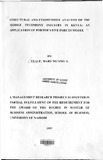| dc.description.abstract | The main objectives of the study were to establish the forces that define the structure of the mobile telephony industry in Kenya and to determine the strength of these forces in
shaping competition in the industry. The study was greatly motivated by the fact that the
mobile telephony industry in Kenya is a growing industry and the players therein are
grappling with the contending forces that shape its structure and competitive behavior.
Questionnaires were administered to Chief Executive Officers or Corporate Strategy
Managers and where these positions did not exist, to credit managers, marketing managers,
and/or managers in charge of strategic planning. The study targeted 5 out of the six
wireless communication providers. All the 5 firms were served with questionnaires, which
they answered and returned, hence achieving a response rate of 100%. Data collected was
analyzed using cluster analysis and presented using tables.
The major findings were that the mobile telephony industry operates within the six forces
that define the industry structure and the competitive behavior. These forces include the
entry barriers; rivalry among existing competitors; customers' bargaining power;
bargaining power of suppliers; government controls; and information an
telecommunications technology, all of which are embodied within the industry and each
plays a major role in defining the industry structure and competition therein.
The study established that there exist barriers to entry in the mobile telephony industry
making the threats of new entrants and substitute products very weak forces. These entry barriers include huge capital outlay required when investing in the industry; enormous
economies of scale enjoyed by companies already in the industry; high degree of brand
identity exhibited by companies in the industry; sharp retaliation by companies in the
industry to any competitive moves by new entrants into the industry; easy access to the
necessary inputs by firms in the industry; and extensive differentiation of products by
companiesin the industry. Rivalry in the industry was found to be fierce more especially
due to the fact that the industry is experiencing fast growth rate; the industry is highly
concentrated and dominated by one or a few firms; and firms in the industry incur high
while a number of firms have high strategic stakes in achieving success in the industry. The
bargaining power of suppliers was found to result due to the fact that suppliers of inputs to
the industry are few and more concentrated than are the mobile service providers and that
firms in the industry have limited input substitutes. Buyers' bargaining power on the other
hand was found to be in existence because buyers are price sensitive and incur no cost to
switch from one service provider to another. Finally, the industry, through government
control, was found to be utterly over-regulated and that developments in technology bear a
lot upon the growth, competitiveness, and profitability of the industry.
The study established that the six forces that define the structure of, and hence competition
in the mobile telephony industry in Kenya, do so to differing degrees of magnitude. The
strongest force was found to information and telecommunications technology with the
highest followed by threat of entry and barriers to entry; rivalry amongst existing firms;
and government controls at equal degrees of magnitude. These were followed by the
bargaining power of supplier and buyers. Further, it was established that different factors
were in play to determine the relative strengths of these forces.
General conclusion is that the mobile telephony industry is a very attractive one but
because the entry barriers are very enormous, and new entrants are barred from entering the
industry, hence a few firms dominate the industry. The government was also found to be a
great inhibitor due to its over-regulation of the industry. For players in the industry, the
phenomenon is such a favorable one because the industry is still growing and the potential
to benefit from economies of scale and learning curve effects is very promising. It was
recommended that the government plays a greater role in deregulating the industry to pave
way for more investments in the industry. | en |

